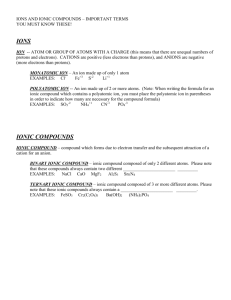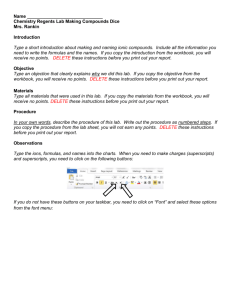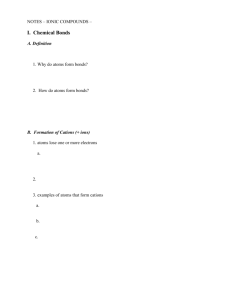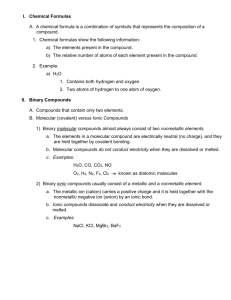Ch. 9 Outline Answers
advertisement
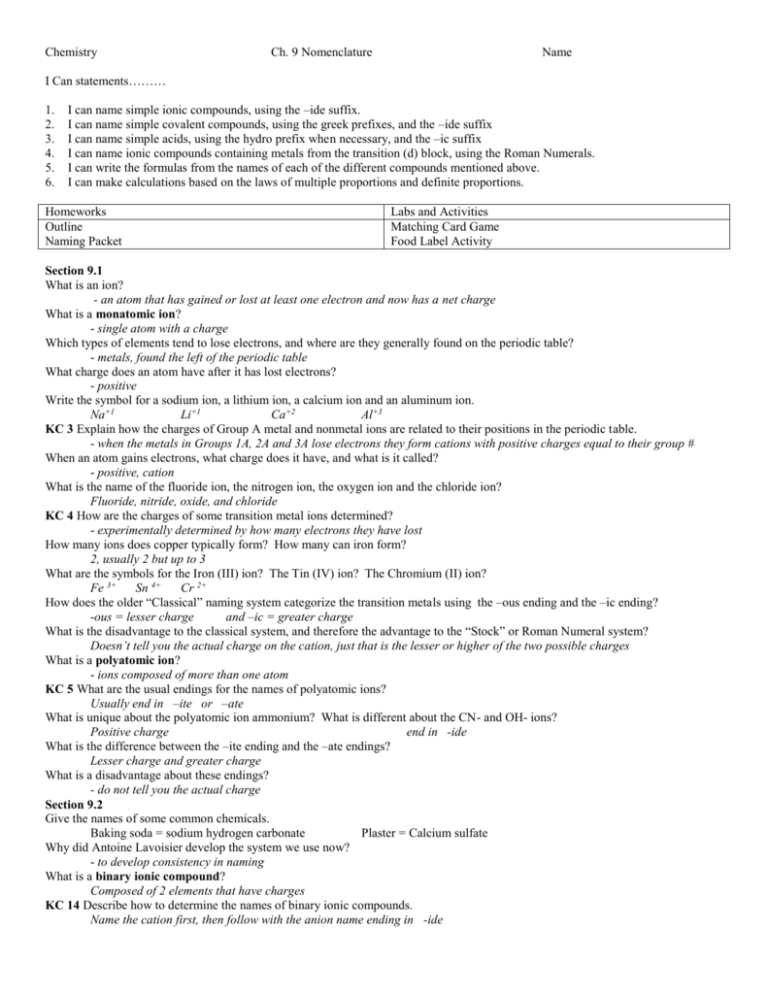
Chemistry Ch. 9 Nomenclature Name I Can statements……… 1. 2. 3. 4. 5. 6. I can name simple ionic compounds, using the –ide suffix. I can name simple covalent compounds, using the greek prefixes, and the –ide suffix I can name simple acids, using the hydro prefix when necessary, and the –ic suffix I can name ionic compounds containing metals from the transition (d) block, using the Roman Numerals. I can write the formulas from the names of each of the different compounds mentioned above. I can make calculations based on the laws of multiple proportions and definite proportions. Homeworks Outline Naming Packet Labs and Activities Matching Card Game Food Label Activity Section 9.1 What is an ion? - an atom that has gained or lost at least one electron and now has a net charge What is a monatomic ion? - single atom with a charge Which types of elements tend to lose electrons, and where are they generally found on the periodic table? - metals, found the left of the periodic table What charge does an atom have after it has lost electrons? - positive Write the symbol for a sodium ion, a lithium ion, a calcium ion and an aluminum ion. Na+1 Li+1 Ca+2 Al+3 KC 3 Explain how the charges of Group A metal and nonmetal ions are related to their positions in the periodic table. - when the metals in Groups 1A, 2A and 3A lose electrons they form cations with positive charges equal to their group # When an atom gains electrons, what charge does it have, and what is it called? - positive, cation What is the name of the fluoride ion, the nitrogen ion, the oxygen ion and the chloride ion? Fluoride, nitride, oxide, and chloride KC 4 How are the charges of some transition metal ions determined? - experimentally determined by how many electrons they have lost How many ions does copper typically form? How many can iron form? 2, usually 2 but up to 3 What are the symbols for the Iron (III) ion? The Tin (IV) ion? The Chromium (II) ion? Fe 3+ Sn 4+ Cr 2+ How does the older “Classical” naming system categorize the transition metals using the –ous ending and the –ic ending? -ous = lesser charge and –ic = greater charge What is the disadvantage to the classical system, and therefore the advantage to the “Stock” or Roman Numeral system? Doesn’t tell you the actual charge on the cation, just that is the lesser or higher of the two possible charges What is a polyatomic ion? - ions composed of more than one atom KC 5 What are the usual endings for the names of polyatomic ions? Usually end in –ite or –ate What is unique about the polyatomic ion ammonium? What is different about the CN- and OH- ions? Positive charge end in -ide What is the difference between the –ite ending and the –ate endings? Lesser charge and greater charge What is a disadvantage about these endings? - do not tell you the actual charge Section 9.2 Give the names of some common chemicals. Baking soda = sodium hydrogen carbonate Plaster = Calcium sulfate Why did Antoine Lavoisier develop the system we use now? - to develop consistency in naming What is a binary ionic compound? Composed of 2 elements that have charges KC 14 Describe how to determine the names of binary ionic compounds. Name the cation first, then follow with the anion name ending in -ide Why is copper oxide an incomplete name? Needs a roman numeral, because there are more than one copper oxide KC 15 Describe how to write the formulas for binary ionic compounds. Write the symbol for the cation and anion and then include subscripts to balance the charges What is the disadvantage to the criss-cross method of using the charges to write the formulas of a binary compound? It doesn’t always work, like with +2 and –2 and with +3 and -3 How can you balance a cation with a +3 charge with an anion with a –2 charge? Least common multiple of six means 2(+3) and 3(-2) KC 16 How do you write the formulas and the names of compounds with polyatomic ions? Write the symbol for the cation and then the formula for the polyatomic and use subscripts to balance the charges What role do parentheses play in writing the formulas for polyatomic compounds? A way to designate that you have multiple sets or packages of a group of atoms, especially like polyatomics Are parentheses always necessary for a polyatomic ion? No, if you only have one set of the polyatomic you don’t need parentheses. Only if you have 2 or more sets/packages What minimum number of atoms are there in a polyatomic ionic compound? 2 Section 9.3 What is a binary molecular compound? 2 atoms bonded together with a covalent bond What is the difference between a binary ionic compound and a binary molecular compound? The bonds are different (Ch. 7/8) and they are named differently Why is using the name carbon oxide insufficient? Carbon and oxygen bond together in multiple ways What are some of the prefixes used in naming binary molecular compounds? Mono, di, tri, tetra, penta, hexa…. KC 20 What information do prefixes in the name of a binary molecular compound tell you about the composition of the compound? They tell you how many atoms of an element are present in the compound All molecular compounds end with what suffix? ide Is a prefix always necessary? Yes, unless there is only one atom of the first element KC 21 Describe how to write the formula of a binary molecular compound. Use the prefixes to tell you the subscripts of each element Section 9.4 What is an acid? A compound that contains one or more hydrogen atoms, and can produce H ions What is the general form of an acid’s formula? H nX KC 26 List the rules for naming an acid. See page 272 KC 27 How are the formulas for acids determined? See page 272 What is a base? An ionic compound that produces hydroxide ions when dissolved in water KC 28 How are bases named? Same as other ionic compounds Section 9.5 KC 35 What two laws describe how chemical compounds form? Law of definite proportions and the law of multiple proportions What is the law of definite proportions? In samples of compounds the masses are always in the same proportions What is the law of multiple proportions? If the same 2 elements form more than one compound the mass ratios will indicate the whole number ratios in the formula Answer Rvw problems #73 and #74 on page 282. KC 36 How should you use a flowchart to name a chemical compound? Follow the arrows and answer the questions Follow the flow chart on page 277 to name the compounds HCl CaF2 Cu(NO3)2 Follow the flow chart on page 278 to write the formulas for the compounds Dinitrogen Pentoxide Magnesium Iodide Chromium (II) Phosphate P2O5 Sulfuric Acid

